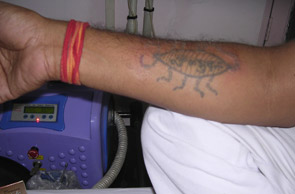+91 999-080-4085 drsandeshg@rediffmail.com
Laser tattoo removal usually refers to those non-invasive removal of tattoo pigments using Q-switch NdYAG (Neodymium Doped Yttrium Aluminium Garnet). Typically, black and darker-colored inks can be removed more completely.


In various surveys conducted worldwide, people give different reasons to remove tattoo i.e.
Tattoo removal is done by lasers that can break down the ink particles in the tattoo. The broken-down ink is then absorbed by the body.
A tattoo laser must be capable of emitting adequate energy within the given absorption spectrum of the pigment to provide an effective breakage of tattoo pigment. There are other colours in tattoo such as yelloww, green and fluorescent which are more challenging to treat over dark black and blue since they have absorption spectra that fall outside the emission spectra available in the tattoo removal laser. Recent pastel colour inks contain high concentrations of titanium dioxide which is highly reflective. Consequently, such inks are difficult to remove.
Generally, tattoos consist of thousands of particles of tattoo pigment suspended in the skin. Tattoo pigment particles are permanent because they are too big to be removed. Laser treatment causes tattoo pigment particles to heat up and fragment into smaller pieces. These smaller pieces are then removed by normal body processes.
Laser tattoo removal is a successful application of the theory of selective photothermolysis (SPTL).
However, unlike treatments for blood vessels or hair the mechanism required to shatter tattoo particles uses the photo mechanical effect. In this situation the energy is absorbed by the ink particles in a very short time, typically nanoseconds. The surface temperature of the ink particles can rise to thousands of degrees but this energy profile rapidly collapses into a shock wave. This shock wave then propagates throughout the local tissue (the dermis) causing brittle structures to fragment. Hence tissues are largely unaffected since they simply vibrate as the shock wave passes. For laser tattoo removal the selective destruction of tattoo pigments depends on four factors:
Although they occur infrequently, mucosal tattoos can be successfully treated with Q-switch lasers as well.
Complete laser tattoo removal requires numerous treatment sessions, typically spaced at least four weeks apart. At each session, some but not all of the tattoo pigment particles are effectively fragmented, and the body removes the smallest fragments over the course of several weeks. The result is that the tattoo is lightened over time. Remaining large particles of tattoo pigment are then targeted at subsequent treatment sessions, causing further lightening. The number of sessions and spacing between treatments depends on various parameters, including the area of the body treated and skin colour.
A predictive scale, the "Kirby-Desai Scale", was developed by Rd. Will Kirby and Rd. Alpesh Desai (dermatologists with specialization in tattoo removal techniques) is present to assess the potential success and number of treatments necessary for laser tattoo removal, Certain colours have proved more difficult to remove than others. For example, the molecular size of the green ink particles being significantly smaller than black colour.
A new technique using two to four passes with the laser, twenty minutes apart, causes more breaking up of the ink than the conventional method.
Call us at +91-9990804085, +91-9990804089 | Email at drsandeshg@rediffmail.com